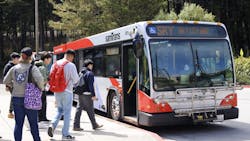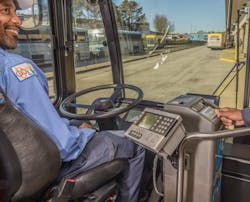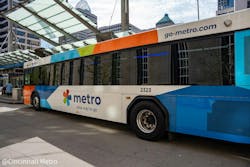Transit agencies expand free and discounted passes for students as new academic year begins
Public transit agencies across the U.S. are offering special passes to students to use public transit to get to school, as the 2025-2026 academic school year gets underway.
San Mateo County Transit District (SamTrans) to offer 5,000 free Way2Go passes
For the second straight year, SamTrans will offer 5,000 free Way2Go passes to students with the greatest financial need at Cañada College, College of San Mateo and Skyline College.
SamTrans notes the program’s first year offered 5,000 passes during the 2024–25 academic school year, giving many students free, unlimited rides on SamTrans buses seven days a week. Funded by a $730,000 City/County Association of Governments (C/CAG) Lifeline Transportation Program Cycle 7 Grant, the initiative totals 10,000 passes over two years. The grant is supported by a $109,000 match from the San Mateo County Community Colleges Foundation (SMCCCD) and a $36,000 match from SamTrans.
“Last year’s program clearly demonstrated the difference reliable, fare-free transportation can make for students who need it most,” said SamTrans Deputy General Manager and CEO David Santoro. “We’re proud to continue this collaboration with SMCCCD and C/CAG in year two and look forward to building on the positive results we’ve already seen.”
The agency says passes will again be distributed through the colleges’ SparkPoint centers, which connect low-income students to essential resources and programs. Outreach to qualifying students began with the start of the fall semester on Aug. 13.
Cobb County, Ga.’s, CobbLinc partners with Kennesaw State University (KSU)
CobbLinc has partnered with KSU to allow students of the university to ride the bus for free by showing a student identification card when boarding. CobbLinc notes its bus routes connect both KSU campuses via the Rapid 10 line, as well as Routes 40 and 45.
Cincinnati Metro to provide transit for Cincinnati Public Schools (CPS)
The city of Cincinnati, CPS and Cincinnati Metro have implemented a series of measures designed to reduce congestion and improve safety at Government Square, downtown’s central bus hub. Starting this academic school year, all CPS students in grades 7–12 will now use Cincinnati Metro to get to school. The agency notes only about 300 of the 13,000 students expected to use Cincinnati Metro this year are anticipated to need a transfer each afternoon at Government Square.
Cincinnati Metro says the initiative will help its public transit network continues to improve, with new and better crosstown routes, which reduce the number of students who need to transfer downtown.
CPS and the agency have also helped students get to school by:
- Introducing RFID-tracked student passes for improved oversight
- Adjusted cutoff times of passes at 5:00 p.m. each school day
- Made Color-coded passes to help identify students with a direct route from those needing to make a transfer.
The agency notes structured communications to families include a robocall initiative that reminds families to use available direct routes- decreasing the number of students traveling through Government Square and messaging that reinforce the student ridership Code of Conduct.
“These improvements show the power of partnership,” said Cincinnati Metro CEO and General Manager Andy Aiello. “Every decision we’ve made—whether it’s adjusting routes, enhancing safety or improving the student pass system—has been about ensuring students have a safe and dependable trip to and from school.”
The city and Cincinnati Metro have also partnered to launch the 311 Community Responder program, with aides offering expanded youth engagement and support at Government Square each afternoon, in addition to Cincinnati Police presence. According to the agency, enhanced safety measures at Government Square and other downtown areas this past year have resulted in a decline in youth-involved calls (down 18%) and incidents of youth-involved crime (down 35%).
Cincinnati Metro had staff stationed at its transit centers during the first week of school to assist families and offered parents the ability to ride free with their student to and from class during the first week.
“By working together, the city, [Cincinnati] Metro and CPS are making sure that students can focus on learning, while families and the community can feel confident that their safety is the top priority,” said City Manager Sheryl Long.
CPS Superintendent Shauna Murphy added, “Strong schools depend on strong communities. We are proud to work with [Cincinnati] Metro and the city to make sure our students arrive safely, on time and ready to learn.”
King County Metro bringing back Youth ORCA card
King County Metro is bringing back the Free Youth Transit Pass, also known as a Youth ORCA card for the 2025-2026 academic school year. The agency notes the pass is good 24/7, 365 days a year. This will be the fourth school year that youth 18 years of age and younger will be able to use it to board transit for free.
According to the agency, once students receive a card, students can tap the card to board any bus, including Community Transit, Everett Transit, Kitsap Transit, Pierce Transit, Snoqualmie Valley Transit and King County Metro, Sound Transit’s Link light rail and Sounder, the King County Metro Water Taxi, Seattle Streetcar, Metro Flex, Washington State Ferries and Monorail.
The agency notes that once a student turns 19 years old, they can add money or a pass onto the card to continue using it as an adult.
Wheels Bus accepting applications for Student Transit Pass Program (STPP)
Wheels Bus System, the Livermore Amador Valley Transit Authority's (LAVTA) public transit system, is now accepting applications for the STPP, which provides eligible 6th-12th graders throughout the Tri-Valley with unlimited free bus rides and 50% off Bay Area Rapid Transit fares.
“The Student Transit Pass Program is a powerful example of how Alameda County Transportation Commission (CTC) delivers on its promise to voters to expand access and improve mobility for all,” said LAVTA Board of Directors Vice Chair and Alameda County District 1 Supervisor David Haubert. “By removing transportation barriers for students, we’re not only helping them succeed in school—we’re also investing in a more vibrant and connected future for Alameda County. I’m proud of Alameda CTC’s leadership in building programs that truly make a difference in people’s daily lives.”
Funded by local transportation sales tax Measure BB, the program began as a pilot in 2016 at just 11 schools. As of 2024, the agency notes every eligible school in Alameda County, Calif., is now participating, ensuring students have access to free bus transportation up through high school graduation.
This year, Alameda CTC anticipates that over 63,000 students at 165 middle and high schools will be eligible. The program supports students traveling to school, jobs and activities by providing reliable and affordable transportation options.
According to the agency, all 6th-12th graders attending the Livermore Valley Joint Unified District can universally apply. Eligibility for the Dublin Unified School District and Pleasanton Unified School District is means based; students whose families meet the California Department of Education’s free or reduced-priced meal income eligibility guidelines may apply. The application provides up to five years of program enrollment based on eligibility.
About the Author
Brandon Lewis
Associate Editor
Brandon Lewis is a recent graduate of Kent State University with a bachelor’s degree in journalism. Lewis is a former freelance editorial assistant at Vehicle Service Pros in Endeavor Business Media’s Vehicle Repair Group. Lewis brings his knowledge of web managing, copyediting and SEO practices to Mass Transit Magazine as an associate editor. He is also a co-host of the Infrastructure Technology Podcast.




